
Disable Find My Device: A Comprehensive Guide
In today's digital age, devices play an integral role in our daily lives. Whether it's an iPhone, Android smartphone, iPad, or another handheld device, these gadgets often come equipped with advanced tracking features designed to help locate them if lost or stolen. One such feature is Find My Device, which allows users to track, ring, lock, or erase their devices remotely. However, there are situations where disabling this feature might be necessary, such as when selling or giving away a device, or simply for privacy concerns. This article will cover the process of disabling Find My Device on various handheld devices.
Why Disable Find My Device?
Before diving into the steps to disable Find My Device, understanding the reasons behind this action is essential. Here are a few reasons:
- Privacy Concerns: Some users might worry about their location data being tracked and shared with Apple or Google, even when the device is not in use.
- Selling or Giving Away Devices: When planning to sell or give away a device, disabling Find My Device ensures the new owner cannot track it.
- Security: Disabling Find My Device can prevent unauthorized access if the device falls into the wrong hands.
Disabling Find My Device on Apple Devices
Apple's Find My feature integrates into various Apple devices, including iPhones, iPads, iPod touches, Macs, and Apple Watches. Here’s how to disable it on each of these devices:
Disabling Find My on iPhone, iPad, or iPod Touch
To disable Find My on an iPhone, iPad, or iPod touch, follow these steps:
- Open Settings: Go to the Settings app.
- Select Your Name: Tap on your name at the top of the screen.
- Find My: Scroll down and select "Find My."
- Disable Find My Device: Tap on "Find My [device name]" and toggle the switch from green (on) to gray (off).
Disabling Find My on your iPhone, iPad, or iPod touch automatically removes Activation Lock, allowing you to sell or give away the device without restrictions.
Disabling Find My on Mac
To disable Find My on a Mac:
- Open System Settings: On macOS 13 or later, choose Apple menu > System Settings. On macOS 12 or earlier, choose Apple menu > System Preferences.
- Select iCloud: Click on "iCloud" in the sidebar.
- Find My Mac: Click on "Find My Mac."
- Turn Off Find My Mac: Click the toggle next to "Find My Mac" to turn it off.
Disabling Find My on a Mac also removes Activation Lock, making it easier to sell or give away the device.
Disabling Find My on Apple Watch
To remove your Apple Watch from Find My:
- Unpair the Watch: Unpair your Apple Watch from your iPhone by going to the Apple Watch app on your iPhone, selecting the watch, and tapping "Unpair Apple Watch."
- Activation Lock Removal: Activation Lock is automatically removed when you unpair the watch.
For detailed instructions, refer to the Apple Watch User Guide or Apple Support articles.
Disabling Find My Device on Android Devices
Android devices also come with a similar feature called Find My Device, which can be disabled as follows:
Disabling Find My Device on Android
To disable Find My Device on an Android device:
- Open Settings: Go to the Settings app.
- Security & Privacy: Tap on "Security & privacy."
- Find My Device: Scroll down and select "Find My Device."
- Toggle Off: Toggle the switch for "Use Find My Device" from green (on) to gray (off).
Additionally, turn off Location Services to ensure that your location data is not shared with other services or apps.
Additional Steps for Android
While disabling Find My Device is straightforward, merely disabling this feature does not stop your phone from sharing your location for all other services. You'll also need to turn off Location Services:
- Open Settings: Go to the Settings app.
- Location: Tap on "Location."
- Toggle Off: Toggle the switch for "Use location" from green (on) to gray (off).
This ensures that no company is keeping your private information by tracking your location.
Disabling Find My Device on Other Devices
AirPods and Beats Headphones
To remove your AirPods or Beats headphones from Find My:
- Put in Case: Put the headphones in their case or turn them off.
- Remove from List: Remove them from your devices list.
For detailed instructions, refer to the user guides for AirPods and Beats headphones.
AirTag and Third-Party Items
To unregister an AirTag or third-party item:
- Open Settings: Go to the Settings app on your iPhone, iPad, or iPod touch.
- Find My: Tap on "Find My."
- Devices: Tap on "Devices."
- Select Device: Select the AirTag or third-party item you want to unregister.
- Erase Device: Tap "Erase This Device."
For detailed instructions, refer to the user guides for AirTag and third-party items.
Final Thoughts
Disabling Find My Device is a straightforward process that can be completed on various handheld devices. Whether you're concerned about privacy, planning to sell or give away a device, or simply want to ensure that no company is tracking your location, following these steps will help you manage your device tracking features effectively. Always refer to the official support resources provided by Apple and Google for the most accurate and up-to-date instructions specific to your device.
